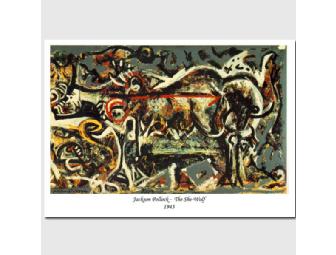Art
"The She-Wolf" by Jackson Pollock (1943)
- Item Number
- 350
- Estimated Value
- 100 USD
- Opening Bid
- 33 USD
Item Description
Details of this item
"The She-Wolf" by Jackson Pollock (1943)
Master Artist Museum Print
Size: 11.7" x 16.5"
Status: Unframed
About the Artist
Paul Jackson Pollock (January 28, 1912 - August 11, 1956) was an influential American painter and a major force in the abstract expressionist movement. His work was a great influence in 20th century art.
The youngest of five sons, Pollock was born in Cody, Wyoming, and grew up in Arizona and California, attending Los Angeles' Manual Arts High School where he studied with Frederick John Schwankovsky before being expelled for fighting and other disruptive behavior. He moved to New York City in 1930, following his brother, Charles Pollock, where they both studied under Thomas Hart Benton at the Art Students League. Benton's influence on Pollock's formative work can be seen in his use of curvilinear undulating rhythms and in the use of rural American subject matter.
Pollock's early representational work was influenced by the Mexican Muralists Siqueiros, Orozco, and Diego Rivera, and even worked in Siqueiros's experimental workshop in 1936. After visiting exhibitions of Picasso and Surrealist Art, his work became increasingly symbolic. He traveled widely throughout the United States during the 1930's, but he settled in New York in 1934 where he worked on the "Works Progress Administration" Federal Art Project from 1935 to 1942. Pollock's first solo show was held at the Peggy Guggenheim The Art of This Century Gallery in New York in 1943.
Pollock had for several years been in psychotherapy to try to cope with depression and this gave him an interest in Carl Jung's theory of primitive archetypes that formed the basis of his work between 1938 and 1944. These works were often violent and were not well received at first.
In 1944 Pollock married his long-term lover Lee Krasner and in 1945, they moved to Springs, in East Hampton, on Long Island, New York. Their home in Springs was typical of the area, a shingle-style wood-frame house with a nearby barn that Pollock eventually made into a studio. Pollock's style changed dramatically in 1947. He began painting with his (often very large) canvases on the floor, and developed what was called his "drip" (or his preferred term, "pour") technique. He used his brushes as implements for dripping paint, and the brush never touched the canvas. Pollock's technique of pouring and dripping paint is thought to be one of the origins of the term Action Painting. In the process of making paintings in this way, he moved away from figurative representation, and challenged the Western tradition of using easel and brush, as well as moving away from use only of the hand and wrist - as he used his whole body to paint. In 1956 Time magazine dubbed Pollock "Jack the Dripper" as a result of his painting style.
SHIPPING AND HANDLING: $29.95
Item Special Note
Museum Prints
Our "Museum Prints" selection includes works from artists such as Edgar Degas, Odilon Redon, Rembrandt, Pierre Auguste Renoir, Hieronymus Bosch, Henri Rousseau, Peter Paul Reubens, Sandro Botticelli, Egon Schiele, Georges Seurat, William Bouguereau, Vincent Van Gogh, Mary Cassatt, Paul Cezanne, Francis Bacon, Salvador Dali, William Blake, Juan Gris and Philip Guston.
Donated By:
ART+more4Good stores data...
Your support matters, so ART+more4Good would like to use your information to keep in touch about things that may matter to you. If you choose to hear from ART+more4Good, we may contact you in the future about our ongoing efforts.
Your privacy is important to us, so ART+more4Good will keep your personal data secure and ART+more4Good will not use it for marketing communications which you have not agreed to receive. At any time, you may withdraw consent by emailing Privacy@frontstream.com or by contacting our Privacy Officer. Please see our Privacy Policy found here PrivacyPolicy.



 ART4GOOD CHARITY NEWS EXCHANGE
ART4GOOD CHARITY NEWS EXCHANGE
 THE ARTIST IN YOU BLOG!
THE ARTIST IN YOU BLOG!
 ART4GOOD ON FACEBOOK
ART4GOOD ON FACEBOOK
 CROWDRISE
CROWDRISE
 Femmena! The Essence of Love for the Epitome of Woman!
Femmena! The Essence of Love for the Epitome of Woman!
 THE ARTIST IN YOU TV CHANNEL!
THE ARTIST IN YOU TV CHANNEL!
 THE ARTIST IN YOU ON TWITTER!
THE ARTIST IN YOU ON TWITTER!